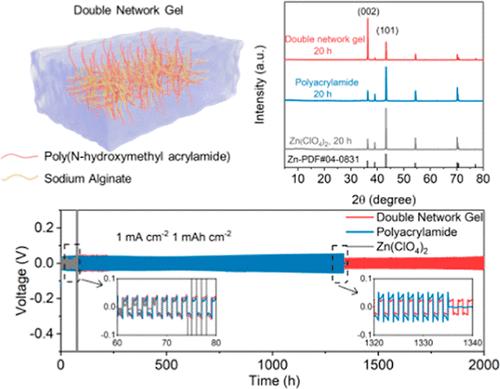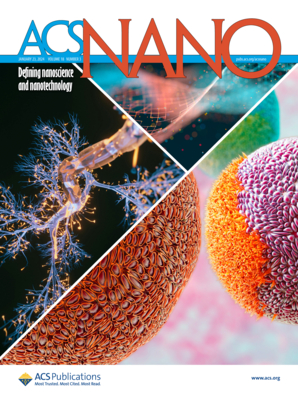Double Network Gel Electrolyte with High Ionic Conductivity and Mechanical Strength for Zinc-Ion Batteries
IF 15.8
1区 材料科学
Q1 CHEMISTRY, MULTIDISCIPLINARY
引用次数: 0
Abstract
Gel electrolytes hold promise for stabilizing zinc-ion batteries (ZIBs), but achieving both high ionic conductivity and strong mechanical properties remains challenging. This work presents a double network gel electrolyte based on poly(N-hydroxymethyl acrylamide) (PNMA) and sodium alginate (SA), overcoming this trade-off. The PNMA network provides mechanical strength and water retention, while the SA network facilitates rapid zinc-ion (Zn2+) diffusion through tailored solvation. This double network gel exhibits a tensile strength of up to 838 kPa, significantly higher than previous reports. The SA network provides ion channels for rapid transport of hydrated Zn2+, enhancing the ionic conductivity to a ground-breaking 33.1 mS cm–1. This value is even higher than the liquid electrolytes. The growth of Zn dendrites is also suppressed due to the mechanical constraint and rapid ion conduction. In symmetrical cells, the PNMA/SA gel demonstrates exceptional cycling stability (>2000 h). Characterizations show this is because of reduced free water amount, hindering cathode material dissolution. The full cells with sodium vanadate cathode manifest a high capacity (364.8 mA h g–1 at 0.5 A g–1) and excellent capacity retention (83% after 2500 cycles at 10 A g–1). This double network design offers a way to achieve high-performance and stable ZIBs.

用于锌-离子电池的高离子传导性和机械强度双网络凝胶电解质
凝胶电解质有望稳定锌离子电池(ZIB),但同时实现高离子电导率和强机械性能仍具有挑战性。本研究提出了一种基于聚(N-羟甲基丙烯酰胺)(PNMA)和海藻酸钠(SA)的双网络凝胶电解质,从而克服了这一权衡问题。PNMA 网络具有机械强度和保水性,而海藻酸钠网络则通过定制的溶解作用促进锌离子 (Zn2+) 的快速扩散。这种双网络凝胶的拉伸强度高达 838 千帕,大大高于之前的报道。SA 网络为水合 Zn2+ 的快速传输提供了离子通道,将离子电导率提高到了 33.1 mS cm-1。这一数值甚至高于液态电解质。由于机械约束和快速离子传导,Zn 树枝状突起的生长也受到抑制。在对称电池中,PNMA/SA 凝胶显示出卓越的循环稳定性(2000 小时)。特性分析表明,这是因为自由水量减少,阻碍了阴极材料的溶解。采用钒酸钠阴极的完整电池具有高容量(0.5 A g-1 时为 364.8 mA h g-1)和出色的容量保持率(10 A g-1 时循环 2500 次后为 83%)。这种双网络设计为实现高性能和稳定的 ZIB 提供了一种方法。
本文章由计算机程序翻译,如有差异,请以英文原文为准。
求助全文
约1分钟内获得全文
求助全文
来源期刊

ACS Nano
工程技术-材料科学:综合
CiteScore
26.00
自引率
4.10%
发文量
1627
审稿时长
1.7 months
期刊介绍:
ACS Nano, published monthly, serves as an international forum for comprehensive articles on nanoscience and nanotechnology research at the intersections of chemistry, biology, materials science, physics, and engineering. The journal fosters communication among scientists in these communities, facilitating collaboration, new research opportunities, and advancements through discoveries. ACS Nano covers synthesis, assembly, characterization, theory, and simulation of nanostructures, nanobiotechnology, nanofabrication, methods and tools for nanoscience and nanotechnology, and self- and directed-assembly. Alongside original research articles, it offers thorough reviews, perspectives on cutting-edge research, and discussions envisioning the future of nanoscience and nanotechnology.
 求助内容:
求助内容: 应助结果提醒方式:
应助结果提醒方式:


